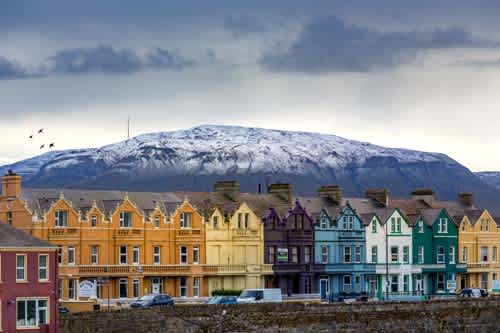County Donegal is one of the larger counties in Ireland, with natural beautiful landscapes, virgin beaches, as well as some of the highest mountains in the country.
About Donegal
The O’Donnell Clan ruled the greater part of the county from about the 14th -17th century. Many castles are witness to this part of history and you can immerse yourself in the culture and history of Ireland by visiting them, especially two of the most splendid castles; the Donegal Castle from the 15th century as well as the 16th century Doe Castle.
The Donegal Bay area offers the opportunity for outdoor activities including golfing, cycling, fishing, hiking and horseback riding. Few people know that there is also an area that is a surfer’s paradise.
A replica of a rural village as it was in the 18th - 19th century is the charming Father McDyer’s Folk Village. You will enjoy the traditional Irish way of life, visiting the thatched-roof houses and crafts workshops and pubs.
The County Donegal is located in the north western corner of Ireland, bordered by the Atlantic Ocean on the west and Northern Ireland on the east known for its endless almost untouched beaches.
The O’Donnell clan “ruled” the greater part of the county of Donegal as well as other nearby areas. They were one of the richest clans and had seven castles throughout, but the Donegal Castle in the middle of the town, overlooking the River Eske is one of Ireland’s most splendid Gaelic castles. It was built in the 15th century as a fortress, fell to ruin but was restored at the beginning of the 1990’s and is now a Heritage Ireland site.
Another interesting castle is the Doe Castle, a stronghold of the MacSweeney Clan for almost 200 years.
The area today has low population, but the positive side is that there are vast areas of wild life conservation (and was named by National Geographic as the "Coolest place on the Planet"). And County Donegal is the starting and ending point of the Wild Atlantic Way that spans the west coast of Ireland.
As in most of the counties with these magnificent landscapes of rolling hills, sandy beaches or flowing rivers, as well as vast open fields, the country offers the traveler lots of outdoor activities like hiking, hill climbing, horse-back riding on the sandy beaches, surfing and much more.
Secret: Not many people associate Ireland with surfing but there are some great surfing spots and Donegal Bay, in the southern part of Donegal County. This is where surfing in Ireland was created and it is the most popular surfing area in the County. Surfer Secret: Mullaghmore, in County of Sligo, is known to be the “best surfing spot” in the country and it is only about 40 km from the city Donegal – but that’s another story!
Ardara is a popular resort especially fishing and walking and hiking. Other popular places to walk and hike are found on the “Loop Trails” such as Errigal, the highest peak in the county and Kinballycrowie Loop.
A “must see” includes Father McDyer’s Folk Village Museum aka the Glencolmcille Folk Village which is in one of Ireland's Gaeltacht regions (Irish-speaking). You can walk through the streets and see a school, fisherman’s dwelling, a pub and of course the small thatch-roofed houses with everything in the house as it was during the 18-20th centuries.




